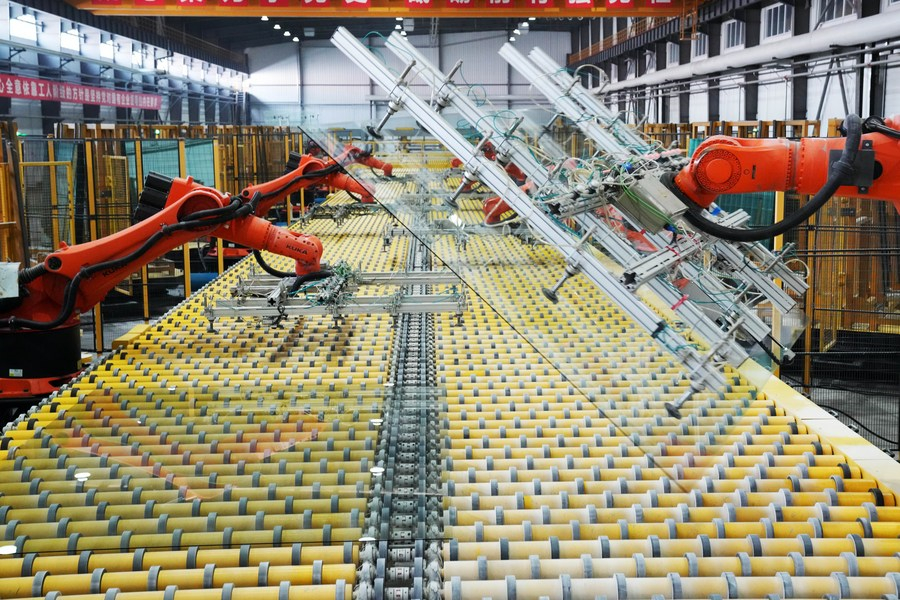How innovation props up China's high-quality development

This photo taken on Feb. 17, 2023 shows robot arms working on a production line at a glass factory in Jiamusi, northeast China's Heilongjiang Province. [Xinhua/Wang Jianwei]
BEIJING -- Sci-tech innovation has played a decisive role in promoting China's high-quality development and modernization drive, just as President Xi Jinping emphasized at the ongoing "two sessions," an important political event concerning the country's further development.
China has made strides in recent years in boosting R&D spending, expanding clean energy production, and nurturing growth poles with regional development strategies, alongside progress in other areas to seek innovative, coordinated, green, open, and shared growth.
Facing fierce global competitions, China must open up new areas and new tracks in development and foster new growth drivers and new strengths, which, fundamentally, depends on sci-tech innovation, said Xi, also general secretary of the Communist Party of China (CPC) Central Committee and chairman of the Central Military Commission, while attending a deliberation with his fellow deputies from the delegation of Jiangsu Province at the first session of the 14th National People's Congress (NPC), the top legislature, on Sunday.
SMARTER MANUFACTURING
At Honor Device Co., Ltd., a smartphone manufacturer located in an intelligent industrial park in the southern Chinese city of Shenzhen, new foldable phones are rolling off the assembly line one after another.
With digital transformation, 75 percent of the processes in the assembly line are completed by automation equipment, and the numerical control rate of key equipment has reached 100 percent.
"The digital platform enables us to track and manage product quality throughout the production process, and improve the production efficiency and quality," said Song Yiwen, president of Honor's supply chain management department.
The manufacturing industry is the top priority of the high-quality development of the economy. According to the report to the 20th CPC National Congress, China will continue to focus on the real economy in pursuing economic growth, and move the manufacturing sector toward higher-end, smarter, and greener production.
Over the past five years, China fully implemented the innovation-driven development strategy and improved and upgraded the industrial structure, said the government work report submitted Sunday to the national legislature for deliberation. The country will accelerate the modernization of the industrial system, according to the report.
In 2022, the added value of China's high-tech manufacturing industry above the designated size increased by 7.4 percent over the previous year, and the investment in high-tech industries increased by 18.9 percent, according to the National Bureau of Statistics.
Intelligent manufacturing is a main technical route and an inevitable option for the innovative development, industrial upgrading, and high-quality development of China's manufacturing industry, said Zhou Ji, an academician with the Chinese Academy of Engineering (CAE).
In Shenzhen, all the 13,000 industrial enterprises above the designated size planned to realize digital transformation by 2025, according to the municipal industry and information technology bureau.
With a total of 65,000 5G base stations, Shenzhen has provided these enterprises with good communication infrastructure, said Yu Xiquan, director of the bureau.
"China's industrial technology level should be constantly advanced to promote the upgrading and transformation of traditional industries through informatization, intellectualization and digitalization," said Zhou Li'an, a professor with the Guanghua School of Management, Peking University, and a member of the CPPCC National Committee.
GREENER DEVELOPMENT
As part of the better quality of development, China has seen reduced energy intensity and carbon emissions.
It has accelerated the building of a green, low-carbon, and circular economic system, and promoted energy revolution and clean production, striving to achieve coordination between economic development and environmental protection.
From 2012 to 2021, China planted 64 million hectares of trees, carried out desertification prevention and control over 18.53 million hectares of land, and added or restored more than 800,000 hectares of wetland, according to a white paper titled "China's Green Development in the New Era" by the State Council Information Office.
Renewable energy has played a more significant role in the country's energy mix. The proportion of clean energy sources in China's total energy consumption increased from 14.5 percent in 2012 to 25.5 percent by the end of 2021, while the proportion of coal decreased from 68.5 percent to 56 percent.
Having set the goal of peaking its carbon dioxide emissions before 2030 and achieving carbon neutrality before 2060, China is also transforming traditional chemical industries into greener ones.
China's first offshore carbon dioxide re-injection well, developed by the China National Offshore Oil Corporation (CNOOC), is about to start drilling in the South China Sea in March.
Energy saving and carbon reduction measures such as associated gas recycling, power networking, and carbon capture, utilization, and storage (CCUS) were deployed in the design of the well to make a long-term plan for the low-carbon transition.
The platform on which the well is located will capture and process the carbon dioxide associated with oil and gas production and then inject it into the seabed for storage. It is estimated that about 300,000 tonnes of carbon dioxide will be stored every year, said Qi Meisheng, general manager of CNOOC Shenzhen Branch.

Aerial photo taken on July 4, 2022 shows a drone carrying out agricultural work in a rice paddy in Dujiazhuang Village, Sandaoba Township, Midong District, Urumqi, northwest China's Xinjiang Uygur Autonomous Region. [Xinhua/Wang Fei]
MODERN AGRICULTURE
China feeds nearly one-fifth of the world's population with only 9 percent of the world's arable land. Xi has stressed that building up strength in agriculture is the foundation of a great modern socialist country, and promoting agricultural modernization is an essential requirement for achieving high-quality development.
Over the past 10 years, agricultural mechanization has made great progress, smart agriculture has taken off rapidly, and rural e-commerce has emerged as a new force in China.
Hong Liangzhong, a farmer from the Lingao village in the Yazhou District of Sanya City in south China's Hainan Province, has recently learned to use biological technology to control cowpea pests and diseases, which has shortened the planting cycle by 10 days, increased the yield by 500 kilos per mu (0.067 hectares), and halved pesticide use.
It was the "doctor village chief" who taught him the new technology.
Last June, 122 doctors from the Chinese Academy of Agricultural Sciences, the Chinese Academy of Tropical Agricultural Sciences, China Agricultural University, Hainan University, and other institutions came to Yazhou, forming 17 work teams of "doctor village chief." They transformed the latest research results from laboratory into stable and high yields.
A seed laboratory in Yazhou has built a public scientific research platform to explore the national new sci-tech innovation model in the field of agriculture.
China will further invigorate the seed industry and support the development of agricultural science, technology, and equipment, according to the government work report.
Scientific and technological progress is the primary driving force of modern agricultural development, said Yin Yulong, a CAE academician who is also an NPC deputy.
Modern agriculture should save costs, increase efficiency, reduce carbon emissions, and take the road of sustainable development, Yin said.
REGIONAL COORDINATION
In recent years, China has unveiled multiple plans to facilitate regional development, such as plans for the coordinated development of the Beijing-Tianjin-Hebei region, the development of the Yangtze Economic Belt, the development of the Guangdong-Hong Kong-Macao Greater Bay Area, and the ecological conservation and high-quality development of the Yellow River basin.
In-depth implementation of coordinated regional development strategies has provided a driving engine and a model path for China's modernization drive.
Located in Guangming Science City in Shenzhen, the large scientific facility for synthetic biology is under intense assembly. With a total investment of nearly 1 billion yuan (about 144 million U.S. dollars), the facility to be partially put into use this year can provide an intelligent and engineered platform for synthetic biology research.
The facility will attract global researchers to carry out sci-tech innovation in the Guangdong-Hong Kong-Macao Greater Bay Area (GBA), said Liu Chenli, chief scientist of the facility.
As a key area supporting the GBA to build itself into an international innovation center, Guangming Science City has laid out 24 sci-tech innovation entities, including large scientific facilities and cutting-edge cross-research platforms. It will become the highland of scientific research cooperation in the future.
The construction of large scientific facilities can not only enhance scientific research resource sharing but also provide a research platform for collaborative innovation to break through the bottleneck of scientific problems, said Xue Qikun, an NPC deputy, who is also an academician of the CAS and president of Southern University of Science and Technology.
























